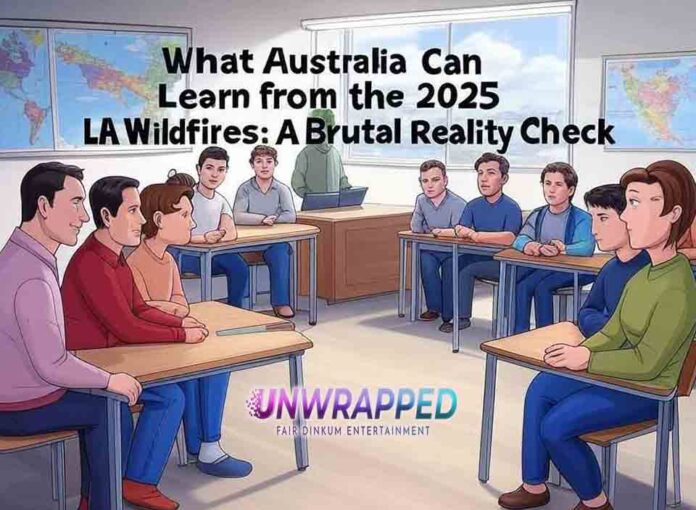Winter Inferno: The Unprecedented LA Wildfire
In January 2025, unprecedented LA wildfires ravaged over 37,000 acres, destroyed more than 12,000 structures, and led to 24 confirmed fatalities within weeks. While these figures are staggering, they only tell part of the story—a story of fear, upheaval, and intense collective trauma. For Australians, they may sound eerily familiar: the echo of our own Australian wildfires and a stark reminder that the next catastrophic blaze might be just around the corner.
A Personal Note:
When Shane, a volunteer firefighter from New South Wales, watched footage of Los Angeles neighborhoods engulfed in flames, he was immediately transported back to the 2019–2020 bushfires. The memories of thick smoke, sleepless nights, and the gnawing worry for his family’s safety flooded in. Across the Pacific, LA resident Maria recounted leaving her home in the dead of night, “It felt like my future was ash in the wind.” Their accounts, though separated by oceans, unite us in our shared vulnerability and resilience.
This article delves into LA wildfires lessons that could shift Australia’s fire preparedness strategies. By weaving together historical insights, emotional human stories, and practical policy reflections, we aim to not only inform but also inspire collective action.
Reflecting on History — Australia’s Fire Legacy
From Black Summer to Black Sorrow
Australia’s bushfires are not new. The “Black Summer” of 2019–2020 was a stark turning point, burning over 18 million hectares and displacing thousands. This tragedy wasn’t just an environmental catastrophe—it was a cultural reckoning that forced us to question our fire preparedness, land management, and climate policies. Aboriginal fire management techniques, once sidelined, began to gain overdue recognition for their sustainable, holistic approach to the land. Yet, systemic changes often remain slow, overshadowed by competing political priorities.
Historical Lessons Unheeded
Despite recurring infernos—from Ash Wednesday in 1983 to Black Saturday in 2009—Australia’s fire readiness still has critical gaps. Some communities have robust volunteer brigades, while others are under-resourced and uninformed. The cultural attitude toward bushfires often swings between stoic acceptance and last-minute panic, a cycle that can leave regions vulnerable and leadership reactive instead of proactive.
The LA Wildfires — A Snapshot of Failure and Fortitude
Infrastructure and Water Woes
In Los Angeles, water hydrants ran dry in some neighborhoods, with around 20% failing during critical firefighting efforts. As power outages disrupted pumping stations, entire suburbs lost precious time they couldn’t afford. For Australia, which regularly grapples with drought conditions, this scenario might not be far-fetched. A similar crisis here would rapidly escalate if major urban centers or regional towns lacked functional backup water systems.
Proactive Planning or Over-Confidence?
Experts in LA had warned about the potential for off-season wildfires—yet many officials believed that winter rains would mitigate the risk. This highlights a universal pitfall: underestimating the rapidly evolving conditions driven by climate change impact. Similarly, Australia has faced repeated criticism for delayed smoke warnings, limited aerial firefighting resources, and an overall hesitation to declare states of emergency until fires have already raged out of control.
Comparative Analysis — Learning Beyond the Surface
Policy Crossovers
- Building Codes: Post-wildfire rebuilds in LA included stricter regulations such as fire-resistant materials and mandatory buffer zones. Australia, still reliant on varied state-by-state codes, could benefit from a unified national standard enforcing mandatory fireproofing in high-risk zones.
- Emergency Alerts: LA’s experience showed that robust, real-time push alerts saved lives. Australia’s current systems are improving but could adopt additional tech-driven approaches—like app-based location tracking and automatic phone messages—refined from LA’s data.
Case Study:
- Ventura County, LA: Adopted “Ready, Set, Go!” campaigns and community drills after multiple wildfire events, resulting in higher preparedness rates.
- Potential Application in Australia: A nationwide “Stay and Defend or Leave Early” approach could integrate ongoing local drills, enabling communities to practice evacuation routes before they’re forced to use them.
What If It Happened Here? A Scenario Planning Exercise
Imagine a scenario where a midsummer heatwave sweeps across southeastern Australia. Combined with strong winds and an electrical fault in a tinder-dry forest, a fire sparks near a major regional city:
- Day One:
- Water storage tanks in the vicinity drop drastically due to high demand.
- Communication lines become overwhelmed, and phone towers shut down intermittently.
- Day Two:
- Major highways clog with evacuations, mirroring the LA exodus.
- Some rural hydrants fail due to inconsistent maintenance and limited reservoir capacity.
- Day Three:
- Residents complain of insufficient alerts—particularly those in remote communities.
- Volunteer brigades work double shifts, facing mental and physical exhaustion, reminiscent of LA’s stretched-thin crews.
In such a scenario, the lessons from LA—improved fire preparedness, robust water infrastructure, real-time updates, and well-supported first responders—could make the difference between contained disaster and large-scale tragedy.
The Emotional Landscape — Trauma, Loss, and Resilience
The Human Toll
The numbers—acres burned, homes lost—often overshadow the personal grief and exhaustion that accompany wildfires. LA residents recount sleepless nights huddled in shelters, unsure if their homes still stood. Australian bushfire survivors know that same fear all too well.
Real Voices:
- Anna, VIC Bushfire Survivor (2020): “I remember the sky turning red at noon. I kept thinking, ‘Will my kids ever feel safe again?’ The scar isn’t just on the land—it’s in our minds.”
- Marcus, LA Firefighter (2025): “I saw entire blocks reduced to embers. Going door-to-door afterwards, we found people who hadn’t evacuated because they didn’t realize how fast the fire could move.”
Supporting Our Heroes
Firefighters and first responders bear the brunt of such disasters. Chronic stress, PTSD, and depression are real dangers. While we praise them as heroes, we must also provide accessible mental health services and fair working conditions, ensuring they aren’t left to cope alone when the smoke clears.
“How prepared do you think your community is for wildfires?”
- Very Prepared
- Somewhat Prepared
- Not Sure
- Not Prepared at All
Constructive Criticism with Empathy
Avoiding the Blame Game
It’s easy to point fingers—at governments, at developers, at climate change deniers. However, meaningful progress arises from solution-oriented discourse. Political leaders operate under complex pressures: economic development, voter expectations, competing budget priorities. That said, climate change impact and increased fire frequency demand a shift in priorities that can no longer be postponed.
Building a United Front
- Collaboration: Public-private partnerships can accelerate innovation, from sophisticated early warning systems to advanced fire-retardant building materials.
- Community Initiative: Local communities can develop neighborhood watch groups or bushfire readiness teams, echoing the success of grassroots programs in LA.
- Bridging Cultural Divides: Indigenous-led land management, known for controlled burns and intimate ecological knowledge, should be actively integrated into mainstream policy.
Action-Oriented Steps for Australia
Individual Responsibilities
- Emergency Kits: Prepare go-bags with essential documents, medications, and supplies.
- Home Assessments: Regularly clear gutters, maintain firebreaks, and invest in fire-resistant home modifications where possible.
- Stay Informed: Sign up for local emergency SMS alerts, and familiarize yourself with evacuation routes.
Community and Organizational Moves
- Local Workshops: Invite experts, including Indigenous custodians, to teach fire management strategies.
- Volunteer Fire Brigades: Support them with funding, training, and mental health resources.
- Advocacy: Engage local councils and state representatives to push for unified, enforceable building codes and updated fire preparedness legislation.
Government and Policy Innovations
- National Aerial Firefighting Fleet: Allocate consistent funding and explore advanced aircraft technologies.
- Sustainable Infrastructure: Upgrade water reservoirs, pumps, and backup power grids, especially in high-risk regions.
- Climate-Smart Urban Planning: Enforce buffer zones and limit housing developments in known fire corridors.
- Indigenous Fire Practices: Integrate traditional controlled burning methods as part of national fire management strategies.
Conclusion
From LA’s “winter inferno” to Australia’s all-too-frequent summer blazes, one truth stands out: we cannot afford complacency. The 2025 LA wildfires delivered a sobering message about how swiftly a modern city can be brought to its knees—an outcome we risk mirroring if we fail to adapt. Yet within these crises lies a profound resilience: courageous neighbors, tireless first responders, and communities united in recovery.
For Australia, the path forward demands more than talk. It requires adopting LA wildfires lessons, embracing climate-focused policies, investing in robust firefighting systems, and recognizing the emotional toll on individuals and communities. The time to act is now—before the next plume of smoke appears on our horizon.
Beyond the Call to Action:
- Join local bushfire readiness groups or start your own.
- Volunteer at community centers offering mental health support to recent fire survivors.
- Contact your local representatives with specific policy requests, such as funding for a national aerial firefighting fleet and stricter building codes.
- Donate to reputable organizations that help rebuild fire-ravaged communities and support the mental well-being of firefighters and residents.
By acknowledging shared vulnerabilities and championing collective responsibility, we can ensure that future generations inherit a safer, more resilient Australia—one that turns the ashes of past disasters into the fertile ground of renewed hope.
Ethical Journalism & Sources
All data cited are drawn from credible outlets like Reuters, AP News, ABC News, and official Australian statistical bodies. Indigenous fire management references are based on public studies and direct statements from community leaders. This piece respects cultural contexts and aims to spark solutions-driven conversation without trivializing any group’s experiences.
- Reuters, AP News: LA wildfire coverage (2025)
- ABC News: Infrastructure challenges
- Australian Bureau of Statistics: 2019–2020 bushfire data
- Government Budget Documents: Resource allocations
- Health Reports, NGOs: Mental health impact
- Climate Change Council, Scientific Journals: Climate change data
- Indigenous Land Management Studies: Controlled burn practices
Remember: Wildfires are more than environmental disasters; they’re deeply human stories about resilience, fear, and, ultimately, our capacity to stand together in the face of overwhelming odds.
See Also: The Ultimate Guide to Van Life: Converting Your Dream Mobile Home










